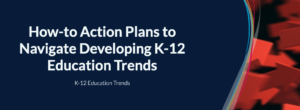
by: Brian Thomas, President and CEO of Lightspeed Systems
Educators are quite familiar with overcoming challenges, as the last four years have presented more disruption to school districts than at any time in recent history. Despite the unparalleled levels of disruption, several developing K-12 education trends have emerged.
This post highlights four prevailing education trends and provides an overview of how-to action plans to get your district proactively addressing its highest-priority challenges.
Cyberattacks on K-12 Schools Continue to Rise
Cybersecurity attacks present a costly threat to school districts across the United States. According to Comparitech, a cybersecurity and online privacy product review website, global ransomware attacks against K-12 and higher education institutions—breaching over 6.7 million personal records—cost over $53 billion in downtime between 2018 and mid-September 2023.
Cyberattacks on K-12 school districts are rising as cybercriminals identify districts as lucrative targets. Student information systems (SIS) store personally identifiable information (PII) of both students and staff, and many districts simply lack the resources to layer essential cybersecurity measures. The result is district data remains increasingly vulnerable to cyberattacks.
The Lightspeed Systems 2022 EdTech App Report showed most districts have more than 2,000 apps in use across their student population, but that only 300 apps account for 99 percent of student use. Regardless of usage rates, district IT leaders are responsible for safeguarding students’ personally identifiable information (PII) on all apps in the district, including the remaining 1,700 infrequently used apps. Unsecure websites and “rogue” apps, those used by staff and students but not vetted by IT, easily slip through the cracks, creating openings for cybercriminals to enter.
Recovering systems after an attack is both costly and time-consuming. In addition to often paying hundreds of thousands of dollars in ransom, district networks are down an average of four days, and require30 days to fully recover.
Action Plan:
- Audit all applications in use across your school district, their privacy policies, and data security practices. Third-party analysis of privacy policies provides a reliable source of expertise. These steps can be completed manually or accelerated with digital intelligence software.
- Block students and staff from accessing new and unknown websites. Millions of new sites come online each day and the vast majority aren’t educational. These sites can be malicious and until they are categorized by your web content filter, the safest option is simply to prohibit access. If you’re using a web filter with an AI-driven dynamic database, educational or appropriate sites won’t remain uncategorized for more than a couple of hours.
- Inform all stakeholders about the importance of cybersecurity and data privacy to empower them with the knowledge to protect their privacy and the community. Mitigate risk by teaching staff and students about phishing emails and rouge apps to help prevent them from unintentionally opening malware that will leave them and your district vulnerable.
Contact your dedicated Account Manager:
Lightspeed Systems
Mike Durando
Vice President of Sales
512-439-3995
mdurando@lightspeedsystems.com
